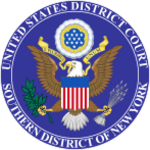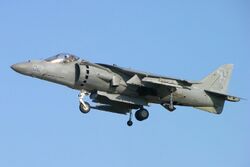Finance:Leonard v. Pepsico, Inc.
| Leonard v. Pepsico, Inc. | |
|---|---|
 | |
| United States District Court for the Southern District of New York | |
| Full case name | John D.R. Leonard v. Pepsico, Inc. |
| Date decided | August 5, 1999 |
| Docket nos. | 96-cv-5320; 96-cv-9069 |
| Citations | 88 F. Supp. 2d 116 |
| Judge sitting | Kimba Wood |
| Case history | |
| Subsequent actions | Affirmed, 210 F.3d 88 (2d Cir. 2000) (per curiam) |
Leonard v. Pepsico, Inc., 88 F. Supp. 2d 116, (S.D.N.Y. 1999), aff'd 210 F.3d 88 (2d Cir. 2000), more widely known as the Pepsi Points case, is an American contract law case regarding offer and acceptance. The case was brought in the United States District Court for the Southern District of New York in 1999; its judgment was written by Kimba Wood.
In 1996, PepsiCo began a promotional loyalty program, in which customers could earn Pepsi Points; these points could, in turn, be traded for physical items. A television commercial for the loyalty program displayed the commercial's protagonist flying to school in a McDonnell Douglas AV-8B Harrier II vertical take off jet aircraft, valued at $37.4 million at the time, which could be redeemed for 7,000,000 Pepsi Points. The plaintiff, John Leonard, discovered a loophole in the promotion, allowing him to purchase Pepsi Points at 10¢ per point. Leonard promptly delivered a check for $700,008.50 to PepsiCo, attempting to purchase the jet. PepsiCo initially refuted Leonard's offer, citing the humorous nature of the offer in the advertisement. Leonard then sued PepsiCo, Inc. in an effort to enforce the offer and acceptance perceived by Leonard to be made in the advertisement. In her judgment, Wood sided with PepsiCo, noting the frivolous and improbable nature of landing a fighter jet in a school zone that was portrayed by the protagonist. PepsiCo would re-release the advertisement, valuing the jet at 700,000,000 Pepsi Points.
Background
Wood's statement of facts, Leonard v. Pepsico, Inc., 88 F. Supp. 2d 116
In the mid-1990s, Pepsi faced competition from Coca-Cola, and sought to attract a younger audience.[1] In March 1996, Pepsi began the Pepsi Stuff promotional campaign, allowing customers to accrue Pepsi Points that could, in turn, be redeemed for items such as T-shirts and leather jackets. These points could be earned through purchasing Pepsi products, with labels attached to the boxes of such products.[2] The campaign was the largest in Pepsi's history.[3] To advertise the promotion, Pepsi released a series of television commercials; one of these commercials showcased a computer-generated Pepsi-branded AV-8 Harrier II, a Harrier jet manufactured by McDonnell Douglas.[2][4] The commercial, which offered the jet for 7,000,000 Pepsi Points, caught the attention of John Leonard, a 21-year-old business student. In place of a label, the promotion allowed Pepsi Points to be directly purchased for 10¢ per point, a detail noticed by Leonard, who convinced five investors to lend him a total of $700,000.[2] Leonard sent a check for $700,008.50 (including $10 for shipping and handling), and 15 labels, per promotion rules. The offer was refused by Pepsi, who referred to the promotion of the Harrier jet in the commercial as "fanciful" and stated its intention was to create a "humorous and entertaining ad".[5]
Procedural history
The claim alleged both breach of contract and fraud. The case was originally brought in Florida, but eventually heard in New York. The defendant, PepsiCo, moved for summary judgment pursuant to Federal Rule of Civil Procedure 56. Among other claims made, Leonard claimed that a federal judge was incapable of deciding on the matter, and that instead the decision had to be made by a jury consisting of members of the "Pepsi Generation" to whom the advertisement would allegedly constitute an offer.[6]
Judgment
The court, presided over by Judge Kimba Wood, rejected Leonard's claims and denied recovery on several grounds, including:
- It was found that the advertisement featuring the jet did not constitute an offer under the Restatement (Second) of Contracts.
- The court found that no reasonable person could have believed that the company seriously intended to convey a jet worth roughly $37.4 million for $700,000, i.e., that it was mere puffery.
- The value of the alleged contract meant that it fell under the provisions of the Statute of Frauds, but the statute's requirement for a written agreement between the parties was not fulfilled, so a contract had not been formed.
In justifying its conclusion that the commercial was "evidently done in jest" and that "The notion of traveling to school in a Harrier Jet is an exaggerated adolescent fantasy," the court made several observations regarding the nature and content of the commercial, including:
- "The callow youth featured in the commercial is a highly improbable pilot, one who could barely be trusted with the keys to his parents' car, much less the prized aircraft of the United States Marine Corps."
- "The teenager's comment that flying a Harrier Jet to school 'sure beats the bus' evinces an improbably insouciant attitude toward the relative difficulty and danger of piloting a fighter plane in a residential area."
- "No school would provide landing space for a student's fighter jet, or condone the disruption the jet's use would cause."
The court also stated that:
In light of the Harrier Jet's well-documented function in attacking and destroying surface and air targets, armed reconnaissance and air interdiction, and offensive and defensive anti-aircraft warfare, depiction of such a jet as a way to get to school in the morning is clearly not serious even if, as plaintiff contends, the jet is capable of being acquired 'in a form that eliminates [its] potential for military use.'[7]
The decision was appealed to the United States Court of Appeals for the Second Circuit, which issued a brief, per curiam opinion concluding, "We affirm for substantially the reasons stated in Judge Wood's opinion."[8]
Aftermath
Pepsi never cashed the check, so there was no case for fraud. Pepsi continued to air the commercial, but it updated the cost of the Harrier Jet to 700 million Pepsi Points[9] and added a clarifying "Just Kidding" disclaimer. The Pentagon stated that the Harrier Jet would not be sold to civilians without "demilitarization", which, in the case of the Harrier, would have included stripping it of its ability to land and take off vertically.[10]
On November 17, 2022, a docuseries about the case titled Pepsi, Where's My Jet? was released on Netflix.[11]
References
- ↑ "Pepsi Introduces a New Look For Its International Markets". The New York Times. April 3, 1996. https://www.nytimes.com/1996/04/03/business/media-business-advertising-pepsi-introduces-new-lookfor-its-international.html.
- ↑ 2.0 2.1 2.2 Haoues, Rachid (January 29, 2015). "Flashback 1996: Man sues Pepsi for not giving him a Harrier Jet". CBS News. https://www.cbsnews.com/news/1996-man-sues-pepsi-for-not-giving-him-a-harrier-jet/.
- ↑ "'Pepsi Stuff' Campaign Set". The New York Times. March 27, 1996. https://www.nytimes.com/1996/03/27/business/the-media-business-pepsi-stuff-campaign-set.html.
- ↑ Chapman, Wilson (October 24, 2022). "Netflix Tackles the Single Dumbest Moment of the Cola Wars in 'Pepsi, Where's My Jet?'". IndieWire. https://www.indiewire.com/2022/10/pepsi-harrier-jet-doc-netflix-trailer-1234775589/.
- ↑ Parker, Matt (January 23, 2020). "Bad Math, Pepsi Points, and the Greatest Plane Non-Crash Ever". Wired. https://www.wired.com/story/bad-math-pepsi-points-greatest-plane-non-crash-ever/. Retrieved November 25, 2022.
- ↑ Epstein, David (2006). Making and doing deals : contracts in context (2nd ed.). Newark, NJ: LexisNexis Matthew Bender. p. 55. ISBN 978-0-8205-7044-0. OCLC 64453463.
- ↑ Leonard v. Pepsico, Inc., 88 F. Supp. 2d 116 (S.D.N.Y. 1999).
- ↑ Leonard v. Pepsico, Inc., 210 F.3d 88 (2d Cir. 2000).
- ↑ Haoues, Rachid (January 29, 2015). "1996: Man sues Pepsi for not giving him the Harrier Jet from its commercial". http://www.cbsnews.com/news/1996-man-sues-pepsi-for-not-giving-him-a-harrier-jet/.
- ↑ Mikkelson, David (May 7, 2011). "Pepsi Harrier Giveaway" (in en-US). http://www.snopes.com/business/deals/pepsijet.asp.
- ↑ Fu, Eddie (October 24, 2022). "A Marketing Blitz Fizzes Out in Pepsi, Where's My Jet? Trailer: Watch" (in en-US). https://consequence.net/2022/10/pepsi-wheres-my-jet-trailer-netflix-documentary-watch/.
- Morales, Ann C (2000). "Pepsi's Harrier Jet Commercial Was Not a Binding Offer to Contract". Journal of the Academy of Marketing Science 28 (2): 318–320.
External links
- Text of Leonard v. Pepsico, Inc., 88 F. Supp. 2d 116 (S.D.N.Y. 1999) is available from: Google Scholar Justia Class Caster
- "Pentagon: Pepsi ad 'not the real thing'". Cable News Network, Inc.. August 9, 1996. http://www.cnn.com/US/9608/09/fringe/pepsi.pentagon/index.html. Retrieved October 5, 2006.
- Leonard v. Pepsico, Inc. Case Brief at Lawnix.com
- Pepsi's Harrier Jet Commercial at YouTube
Template:United States contract case lawTemplate:PepsiCo
 |


